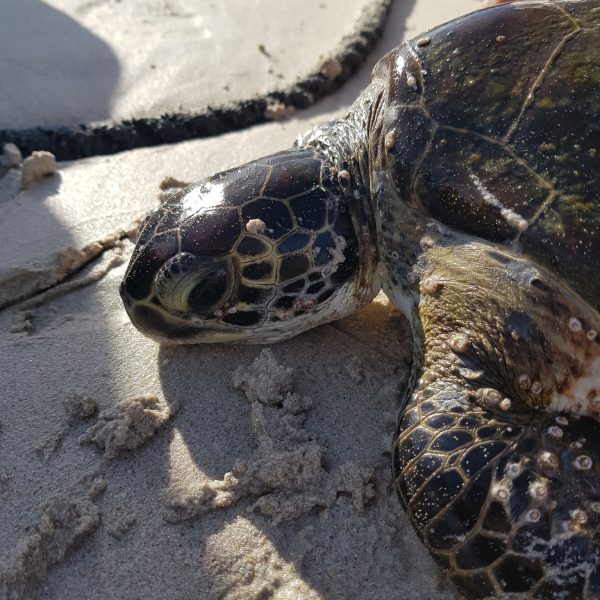
Olive Ridley turtle nesting site in Dabhol project's backyard faces threat

The Konkan coast houses a lesser-known Olive Ridley turtle nesting site near the Dabhol power project, facing a potential threat from a proposed road network that has caused concern among environmentalists. Maharashtra Chief Minister Eknath Shinde has also expressed alarm at the situation.
Every year between October and March, dozens of female Olive Ridley turtles, the smallest of all sea turtles in the world, swim many miles to the 6.5 km pristine Guhagar beach to lay their eggs. And it is to preserve their nesting ground to which they return year after year that Shinde earlier this month ordered immediate action to stop the road project, according to activists and official letters.
Also Read: West Antarctica lost over 3,000 bn tonnes of ice in 25 years: Study
The proposal to build a large network of 12 metre roads along the beach and to the hinterland threatened the eco-sensitive nesting site. This prompted a letter by environmentalists asking that the government stop any further work on the project detailed in a Draft Development Plan published by the Guhagar Nagar Panchayat on February 9.
The letter set the wheels rolling.
Maharashtra Industry Minister (and concurrent district minister) Uday Samant wrote to the chief minister, saying the plan had not “considered the ecology and geographical situation of Guhagar town”.
The minister in the letter, a copy of which was viewed by PTI, said locals had complained that the proposed plan would “totally destroy the environment and hugely harm the precious wildlife in the area”. He sought cancellation of the proposed development plan.
Also Read: Why your pet poodle and tabby cat are nothing like their fierce ancestors
Taking note, Shinde asked his additional chief secretary for urban development to act immediately, officials said.
The Guhagar beach is a sanctuary of various rare birds and marine life, including the Olive Ridley turtle protected under Schedule I of the Wildlife Protection Act, 1972.
The turtles get their name from their olive-coloured carapace, which is heart-shaped and rounded. They are known for their unique mass nesting called arribada, where females come together on the same beach to lay eggs. They lay their eggs in conical nests about one and a half feet deep which they laboriously dig with their hind flippers.
The Odisha coast is the largest mass nesting site for Olive Ridleys and Guhagar a smaller site. At Guhagar, environmentalists and locals conserve the nests and release the hatchlings once they come out of eggs after about 45-65 days.
Environmentalist Bittu Sahgal expressed his shock at the road plan that could destroy the nesting site.
Also Read: Chandrayaan-3 and Aditya L1 missions may take off by mid-2023: ISRO chief
“I am familiar with the golden sands of Ratnagiri’s Guhagar beach. It is one of Maharashtra’s jewels, better than most beaches that people travel half-way across the world to see.
“I am shocked to hear that ignoring an alternative alignment just a little east of the Guhagar beach, a broad tar road has been planned by the Guhagar Nagar Panchayat, virtually touching the beach. Such a road will harm the endangered Olive Ridley turtles that come ashore to nest, Sahgal, who is also editor of the Sanctuary magazine, told PTI.
Long-time resident Samir Kale said the proposed road running along the white sand Guhagar beach runs for almost 6.5 km and will involve cutting over 5,000 coconut and areca nut trees.
This is violative of coastal regulations and will destroy the natural habitats of several species of sea turtles, animals and birds, severely impacting the livelihood of locals,” Kale said.
Also Read: IPCC report urges action, especially from countries like India: Co-authors
Earlier this month, two records were set on Guhagar Beach – 200 Olive Ridley nests were conserved and 162 hatchlings released in one evening. This was the first time along the Konkan coast that so many nests have been detected and conserved in one season, according to activists.
Olive Ridley female turtles usually start visiting Guhagar beach to lay eggs from October onwards. The local Turtle Conservation Centre activists then relocate the nests in the protected environment to ensure they dont fall prey to dogs, foxes, birds and other predators.
This year, however, this process was delayed and the turtle nests started to appear on the beach only in the month of December, they said.
From that time onwards, the nests were found almost every day on the Guhagar beach. This month, the 200th nest – a record for the beach – was reared at the Guhagar Turtle Conservation Centre. As many as 21,402 Olive Ridley turtle eggs have been conserved this year, the activists said.
Also Read: Study provides new insights into drug-resistant tuberculosis
The Olive Ridley conservation movement has been active in Guhagar for the last 16 years due to the efforts put in by both the local activists, organisations and the Maharashtra Forest Department.
Every year during the season, activists scan the stretch of the beach morning and evening for Olive Ridley nests and then conserve those nests in a protected environment till the eggs begin to hatch. The new born hatchlings are then released into the open sea, putting Guhagar beach on the Olive Ridley map of the world.
The $3 billion mega Dabhol power project was set up bankrupt US energy giant Enron and its associates Dabhol Power Corporation in 1996 after signing of a Power Purchase Agreement (PPA) with Maharashtra State Electricity Board (MSEB) in 1993. It got mired in a mega corruption scandal.
(With agency inputs)

